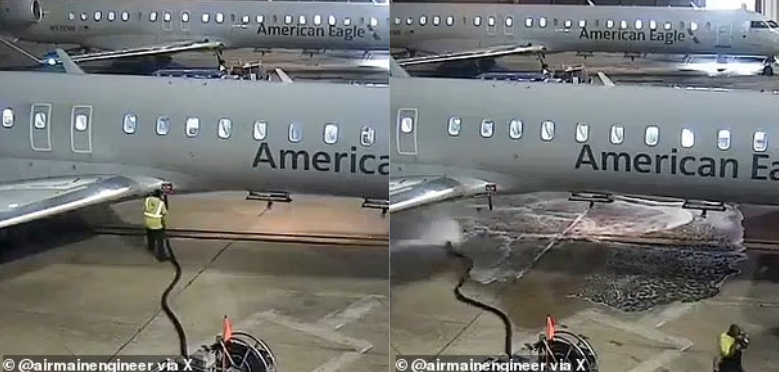
Nothing quite prepares you for the sight of a massive jet fuel fountain erupting across an airport tarmac.
At Dallas Fort Worth International Airport, that’s exactly what stunned passengers and ground crew witnessed when a routine refuelling operation went spectacularly wrong.
Within seconds, what should have been a simple procedure turned into a chaotic scene of high-pressure fuel spraying in every direction.
The incident unfolded on 11 October 2025, when an American Airlines ramp worker reportedly unscrewed a pressurised fuel fitting during refuelling of an American Eagle regional jet.
What followed was thousands of litres of jet fuel gushing across the tarmac, coating the pavement and surrounding equipment in the highly flammable substance.
According to witnesses, the worker appeared to lose control as the pressurised hose whipped around violently, sending fuel spraying like an out-of-control sprinkler system.
Footage that quickly spread on social media captured the shocking moment in detail, showing the ramp worker ducking to shield his face before sprinting towards the fuel truck to shut off the pump.
How a routine task turned into chaos
Eyewitnesses said the worker had just finished refuelling when he tried to disconnect the hose from the aircraft’s fuel port—but fuel was still actively being pumped.
As soon as the hose was detached, it thrashed uncontrollably, spraying fuel in every direction.
The aircraft involved, a Bombardier CRJ-900 registered as N593NN, has been part of the American Eagle fleet since May 2016.
For roughly a full minute, the ramp was transformed into what one aviation blogger jokingly called a ‘slip-and-slide’.
'Bro didn't refuel the plane—he refueled the entire ramp.'
The technical details behind the disaster
So, what went so disastrously wrong?
Reports suggest the worker unscrewed a pressurised fuel fitting without taking the necessary precautions, triggering the spray and subsequent flood of jet fuel.
In simple terms, it’s like opening a shaken soft drink bottle—only this one was filled with highly flammable liquid under immense pressure.
Aviation refuelling systems are designed with several safety measures to prevent such incidents, including something called a ‘deadman switch’, which automatically stops fuel flow when released.
Many ramp agents have since speculated that the issue might not have been human error at all, but rather a mechanical fault—perhaps a damaged hose or malfunctioning pump.
However, aviation safety experts have pointed out that the proper protocol should include shutting off the pump and depressurising the system before disconnecting any fittings.
Aviation fuel safety basics
Modern aircraft refuelling systems include multiple safety layers: grounding cables to prevent static electricity, pressure relief valves, automatic shut-off systems, and deadman switches that stop fuel flow instantly when released.
Industry guidance highlights depressurising fittings, verifying shutoffs, grounding and bonding, and boosting training and supervision to prevent such incidents.
Swift response prevents disaster
Despite the chaos, emergency crews responded with impressive speed.
Specialised absorption materials were deployed to contain and remove the fuel, and cleanup efforts began almost immediately.
By 12 October, officials confirmed there were no reported injuries or aircraft damage.
American Airlines issued a statement to #The New York Post, saying: ‘We are looking into the incident with DFW Airport and the airport's fueling contractor, Menzies, and worked together on the cleanup per procedure.’
Nearby gates were briefly paused during the cleanup, but normal operations resumed soon after.
Aviation safety in perspective
While the footage from Dallas Fort Worth was undeniably dramatic, it’s important to remember that fuel spills—though rare—are not unheard of in aviation.
Almost exactly a year earlier, a Eurowings flight in Düsseldorf had to be evacuated when a refuelling truck driver accidentally struck a bollard and ruptured his tanker.
The key difference in these incidents lies in the response.
Modern airports are equipped with advanced emergency systems, and ground staff undergo extensive safety training to handle flammable materials and high-pressure systems.
Even so, aviation experts stress that there’s no room for complacency—routine equipment checks and strict adherence to safety procedures remain essential.
What happens next?
Investigations are expected to review whether the mishap stemmed from human error, mechanical failure, or a breakdown in safety procedures.
Such reviews typically assess everything from training logs to equipment inspection records.
For passengers, it’s a stark reminder of the countless safety steps that go into every flight—and how quickly trained professionals can act when something goes wrong.
What this means for air travellers
- Fuel spills like this are rare but not unheard of in aviation
- Multiple safety systems are designed to prevent and contain such incidents
- Emergency response procedures are well-established and effective
- No passengers were endangered during this incident
What This Means For You
The Dallas Fort Worth spill occurred when a pressurised fuel fitting was mishandled during refuelling, creating a dramatic but contained incident.
Thanks to quick emergency action, no one was injured and the aircraft suffered no damage.
Experts believe mechanical faults may have played a role, underscoring that even small equipment issues can have serious consequences.
This event highlights the critical importance of thorough training, regular maintenance, and rapid response in aviation safety—reminding travellers that every flight involves carefully managed procedures to keep passengers safe.
If the jet fuel spill at Dallas Fort Worth made you think about how quickly things can go wrong in aviation, there’s another real-life example worth checking out.
An unexpected mid-air emergency on an international flight shows just how critical emergency preparedness and trained crew responses are for passenger safety.
It’s a reminder that behind every smooth flight, there are countless procedures and protocols working to prevent incidents from turning serious.
Read more: Unexpected emergency delays international flight—what passengers experienced mid-air
Dallas Fort Worth worker runways refueling American Eagle jet — Reports on the jet fuel spill at DFW Airport after an American Airlines ramp worker mishandled a pressurised fuel fitting.
https://www.dailymail.co.uk/news/article-15185873/dallas-fort-worth-worker-runway-refueling-american-eagle-jet.html?ns_mchannel=rss&ns_campaign=1490&ito=1490
DFW Jet Fuel Spill: American Ramp Worker Sparks Safety Scrutiny — Details the spill on 11 October 2025 and the risks it created for the ramp area.
https://www.visaverge.com/news/dfw-jet-fuel-spill-american-ramp-worker-sparks-safety-scrutiny/
Jet Fuel Erupts at DFW: American Eagle Refueling Accident Floods Area Around Aircraft—The Bulkhead Seat — Eyewitness accounts of the worker attempting to disconnect the hose while fuel was still pumping.
https://thebulkheadseat.com/jet-fuel-erupts-at-dfw-american-eagle-refueling-accident-floods-area-around-aircraft/
American Airlines Passengers Escapes Disaster Amid Fuel Spill at Dallas Fort Worth Airport—Aviation A2Z — Information on the aircraft involved and background on the Bombardier CRJ-900.
https://aviationa2z.com/index.php/2025/10/13/american-airlines-flight-escapes-fuel-spill-scare-at-dfw/
Airport Worker’s Attempt to Refuel Aircraft Goes Horribly Wrong in Wild Video — American Airlines confirms the incident and details cooperation with DFW Airport and the fueling contractor for cleanup.
https://www.thedailybeast.com/airport-workers-attempt-to-refuel-aircraft-goes-horribly-wrong-in-wild-video
Watch: American Airlines Ground Worker Loses Control Of Refueling Hose Leading To Massive Fuel Leak — Contextualises fuel spills as rare but possible and references a similar incident in Düsseldorf.
https://www.paddleyourownkanoo.com/2025/10/12/watch-american-airlines-ground-worker-loses-control-of-refueling-hose-leading-to-massive-fuel-leak/
Even when chaos erupts on the tarmac, incidents like this prove that aviation safety systems are built to work—how would you react if you witnessed something like this firsthand?







